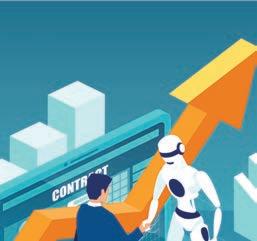
3 minute read
The Artificial Intelligence Challenge
BY TRACEY BEBERMAN
IMAGINE A WORLD where you have quicker access to information and insights that can help you make business decisions faster, make your customer service more efficient, and engage your employees more than ever. Thanks to the integration of artificial intelligence (AI) into work, this is quickly becoming a reality.
And not just at Chase, where we’ve been using AI and machine learning for more than a decade. With the rise of tools like ChatGPT and AI copilots, there are more ways than ever for companies of all sizes to tap into the power of AI.
AI in action
How does it work? To start, AI’s ability to process vast amounts of data at lightning speed is one of its most significant advantages. AI-driven analytics can help a business better manage risk, detect fraud, or improve productivity, for example. Additionally, machine learning models can spot patterns and anomalies that humans might miss, making it an ideal way to optimize business processes.
AI can also augment how workers approach everyday tasks. At Chase, we’ve rolled out LLM Suite—an internal tool that delivers large language model capabilities to employees safely and responsibly. By entering a simple prompt, employees can use LLM Suite as an assistant to complete tasks like writing emails, summarizing large amounts of information, or brainstorming new ideas. Not only does this save time, but it also frees up employees to focus on more strategic and creative work.
Companies can apply similar AI tools to glean new insights that improve customer satisfaction and deliver more efficient service. This is true in Chase’s contact centers, where customers call 24 hours a day to ask for help with a wide range of questions. Using AI to analyze those conversations yields valuable insights about customer needs, creates a continuous feedback loop between voice and digital service channels, and uncovers real-time opportunities for improvement.
AI is also contributing to a culture of continuous learning. As AI advances, there’s a greater emphasis on upskilling and reskilling programs to ensure employees remain productive. Chase offers training sessions, webinars, and other learning resources to build employee knowledge in these new areas.
Getting started with AI
I lead a team of AI experts and am often asked for advice about how to get started in this space. First, build your AI mindset. That means learning how to use these tools, whether at work or at home.
Next, prepare your team to think with an AI mindset. Technology is accelerating at a tremendous rate. Empower employees to try out these tools—in a responsible way—and share their ideas so your full team benefits from the innovation. Lastly, don’t overlook the risks and uncertainties that may come with using AI. Looking ahead, AI’s role in driving innovation and growth will only get bigger. It’s critical that issues like governance, data privacy, bias, and transparency remain at the forefront of AI development and deployment.
AI isn’t the future—it’s the present. It’s already reshaping the workplace, and we’re just scratching the surface of what’s possible.
Tracey Beberman leads machine learning and intelligence operations for Consumer and Community Banking at Chase.










